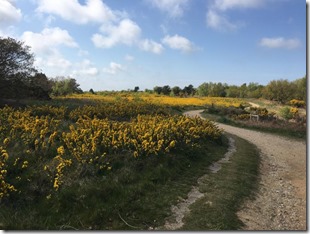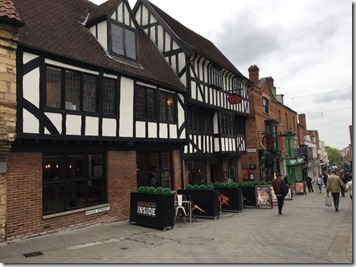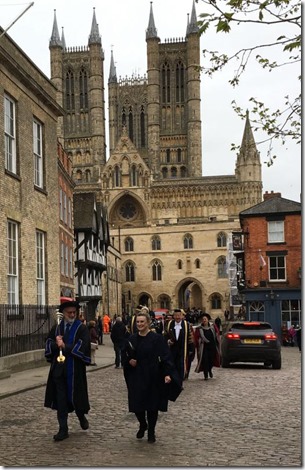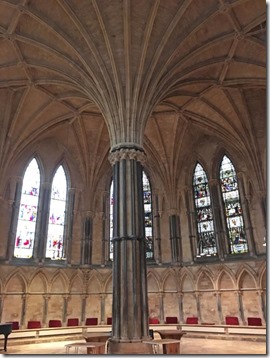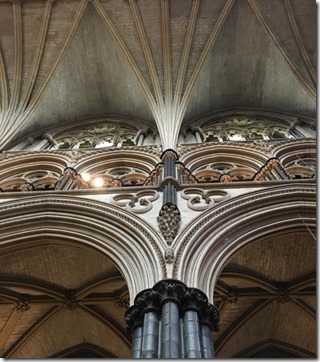Two very different towers: on the left, one of the 83m (272ft) high towers of Lincoln Cathedral and, on the right, the 156m (512ft) high Barclays Building at Canary Wharf in London. In the 12th century the spires of Lincoln Cathedral made it the tallest building in the world. Today the Barclays Building is overshadowed by even taller buildings in London. All photographs copyright Pip Pointon.
David and I had a great time together on our Enjoying Britain adventures and we had more planned when he died so suddenly in May 2019. Finally, almost three years later (partly due to Covid 19) I decided it was time to ‘break out’ and begin again, this time on my own. Not that I was too adventurous for my first journey, as I went back to North Norfolk and then to my son, Eddie, in East London (Canary Wharf and Greenwich). It was on the way home that I did something that David and I had always planned to do – and that was to spend a day in Lincoln.
I had a very comfortable drive to North Norfolk thanks to David’s old Mercedes B Class. The A47 in Norfolk always tests one’s patience as a driver and this time it had a particularly tiresome obstacle: an hour-long queue to get over Sutton Bridge due to the work being carried out on it. I had planned to have a break from driving after Kings Lynn but after that holdup I decided to keep going. It was such a relief, six hours after leaving home, when I reached Sue Bondi’s home. It was a bitter sweet reunion for her husband, Jim (David’s best friend), died very suddenly on Christmas Eve 2020 and this was the first time we had been together since. Sue made me very welcome – as did Dotty her little dog.
We had spent so many great times together boating on the Broads but the deaths of David and Jim had ended all that. On our first day together Sue and I visited one of my favourite spots: the riverside park at Coltishall where we met her daughter-in-law, Amy. From there we went shopping at Roys in Wroxham. So many memories – especially of staring up at the ancient stonework of the single-span bridge at Wroxham, just two to three inches above us, as David steered his boat towards the moorings. Neither Jim nor David needed a pilot to help them – although we had to time it carefully to ensure that the water level was low enough. For Dotty we included a walk through Felbrigg Hall park.
Below: heading under Wroxham bridge, and (right) David approaching it in Edna May.
Among my many happy memories were our dinners at the Roman Camp Inn at Aylmerton – and Sue and I were not disappointed when we went there for a meal. One reason I find it difficult to travel is because I have so many serious food intolerances now and can be quite ill if I eat even the tiniest amount of something that I react to. Going out for a meal has become such a luxury. Before I left home I had checked the website of the Roman Camp Inn and had spotted one of my favourites – beer battered fish. I had phoned the Inn and been assured there was no milk in the batter and they could provide me with a meal free from chips, tomatoes or any soya. And so I was able to take Sue out which was very special for both of us after lockdowns and self-isolation. There was an even bigger surprise as the chef produced a wonderful Eton Mess dessert for me using meringue, poached pears, berries and thick coconut milk.
We made the most of the good weather on the Thursday, walking the promenade at Sheringham, shopping in its amazingly busy high street (a great place for browsing), and then on to Blakeney for our picnic lunch (I had taken my own homemade bread to Norfolk). We spent the afternoon in Sheringham Park where some of the rhododendrons were already in bloom. Later in May and early June the Park would be awash in colour with spectacular displays of flowering rhododendrons and azaleas. But the early bloomers flaunted their beauty with abandon. (Below)
Our walk on Friday morning was to Roman Camp – the hilly vantage point the Romans used to keep watch over the North Sea. And where Jim had died. Later that day Sue drove me to Cromer station so that I could take the train to London. My main memory of the journey to Norwich were the serried ranks of solar panels enveloping several farm fields.
For someone who knew London well in the late 1960s and early 1970s the changing landscape of the city is a constant surprise – and that was certainly true as I walked out of Liverpool Station. There are some old buildings left but they are completely dominated by modern high-rise apartment and office buildings. (Below)
Eddie and Lauren met me at the station and organised a Uber taxi to take us to where they live by Limehouse Basin. I did manage to visit them last year and enjoyed walking round the marina, seeking out the few older buildings (such as St Anne’s Church, Limehouse).
On Saturday morning Lauren suggested we went out for coffee at the Yurt Cafe before we had breakfast. This was just round the corner from Limehouse Station – and what a lovely surprise, especially as the staff made a great coffee barista using oat milk. This Mongolian tent cafe which is part of the Royal Foundation of St Katharine. The latter owes its existence to Queen Matilda who made the initial endowment in 1147.
After breakfast we went to Canary Wharf, enjoying the promenade by the river, Westferry Circus and the Crossrail Place Roof Garden, before Eddie took us to visit his work place on the 26th floor of the 32-storey Barclays Building. Even though it was virtually empty it was so warm inside. Up on the 26th floor there were some amazing views over London and towards Greenwich – and yet more building sites. (Below: the view over the Isle of Dogs to The Millennium Dome)
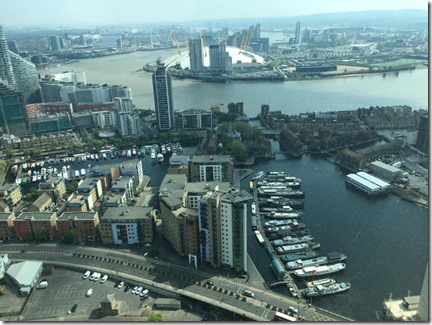 And then there were the self-flushing toilets! Just stand back and it all happens. Eddie said these were introduced during the pandemic along with other measures to reduce the possibility of sharing the dreaded virus. Another surprise that day was how relaxed people were – either when shopping at Waitrose, in the underground shopping precinct, or on the Docklands Light Railway (DLR). A few people were wearing masks but those daunting days of Covid 19 were obviously becoming just a memory.
And then there were the self-flushing toilets! Just stand back and it all happens. Eddie said these were introduced during the pandemic along with other measures to reduce the possibility of sharing the dreaded virus. Another surprise that day was how relaxed people were – either when shopping at Waitrose, in the underground shopping precinct, or on the Docklands Light Railway (DLR). A few people were wearing masks but those daunting days of Covid 19 were obviously becoming just a memory.
The following day we took the DLR to Greenwich. Sunday was obviously the day to promenade in Greenwich Park. We walked up the hill past the Queen Elizabeth Oak to the Flower Garden watching children and dogs playing and adults sitting on the grass enjoying that lovely open space away from all those over-powering tower blocks. We wandered back past The Pavilion Coffee to the Royal Observatory for a right royal view of London.
Our walk back to the station took us past some beautiful Georgian buildings, Goddards famous pie and mash restaurant (on left in photo below with the Cutty Sark in background) and through Greenwich Market, Sometime I would like to go back and explore the town of Greenwich. (I visited Cutty Sark and the Maritime Museum with David in 2013).
Back at Eddie’s flat I continued my journey of exploration using my iPad as I wanted to know more about an intriguing place called Mudchute on the Isle of Dogs which we had passed on the train. I was fascinated to read that it got its name from having mud dumped there when Millwall Dock nearby had to be constantly dredged in the 19th century. Much of the area was saved from development in the 1970s by the Association of Island Communities. The community charity, The Mudchute Association, was set up to administer the 32-acre farm and park with many activities for visitors.
The following day I experienced a surreal moment in the Uber taxi back to Liverpool Station. The driver had left Bangladesh and come to live in Tower Hamlets in 1972. He had watched as the population doubled and maybe tripled with the construction of higher and higher blocks of flats. Back in 1972 I started my travels by going to Bangladesh – a country then still very scarred by the recent war of independence. The taxi driver happily chatted about all the changes he had witnessed in Tower Hamlets and I was very much the tourist! I was glad to get back to the open countryside of North Norfolk. Sue and Dotty met me at the station.
That afternoon we walked through Kelling Heath. The last time I had seen this area of outstanding natural beauty had been from the North Norfolk Railway. This time Sue and I managed to leave a good viewing point maybe ten minutes before a steam train would have made a photograph a lot more interesting.
When I left Sue on the Tuesday I decided I would visit Hunstanton – the place I had intended to stop at a week earlier. Road works again caused confusion and delay! And doubled the length of the journey. Its Cliff Parade proved to be a great place to park, have my picnic lunch and go for a walk but I didn’t join the fossil hunters under those famous striped cliffs
David and I had often taken the A15 from Hull to North Norfolk and had promised ourselves that someday we would stop in Lincoln. But we never did. So, this time, I had booked two nights at the Premier Inn at Canwick on the outskirts of Lincoln. The facilities proved as good as ever and there was free parking. It was so easy then to drive to the park and ride car parking area beside Waitrose and take the bus. I did, however, have a problem finding the bus stop as the park and ride buses do not go into the Waitrose car park. Then I made what seemed to be a critical mistake – I didn’t get off at the Cathedral bus stop. Instead, I ended up at the bus station at the bottom of the hill.
I hadn’t done much research or planned a route beforehand but instead I went from one interesting old building or view to another. The first to catch my attention was the imposing Tudor building which now houses Stokes cafe and a pastry shop (below left). Later I read with interest about it being on top of High Bridge – the oldest bridge in England with buildings on it. The present bridge dates back to the 12th century. A few minutes later I was crossing the River Witham where I stopped to contemplate the aluminium and steel sculpture by Stephen Broadbent entitled Empowerment. (Below right) I read later about this millennium project: ‘The design is intended to echo the shape of turbine blades, in recognition of Lincoln’s industrial heritage, which transform into dynamic figures that reach out to empower one another, just as the blades empower one another within the turbine.’ (Wikipedia).
Walking on I could see the 16th century Guildhall with its archway known as the Stonebow. (Below left) I was captivated not only by the architecture but also the white duvet under the pillars of the Stonebow where a street-sleeper had obviously staked his claim to a rain-proof piece of pavement.
before long I was wandering along The Strait and up Steep Hill with its 12th century buildings. When I reached the top I was so grateful I had been using the fitness equipment at Yoredale Leisure Centre for several months as I wouldn’t have done that so easily late last year. I stopped to look at the Jew’s House and Jews’ Court (below right) which date from the 12th century. It’s hard to imagine Lincoln City Council, back in the 1920s, proposing to demolish the Jew’s Court as part of a slum clearance programme! Thankfully it wasn’t.
I decided not to visit the Castle as I especially wanted to go in the Cathedral. But I did see a university graduation procession from the Cathedral to the Castle grounds. The graduation ceremonies that day meant that the Cathedral nave was closed to visitors. (Below left – one of the graduation processions that day. Right: a family enjoying the graduation day under the stony gaze of the Gallery of Kings at the Cathedral.)
But there was still plenty to see including the 13th century decagonal Chapter House with its single, central column holding up its amazing umbrella of vaults (Below left). I had decided to leave my large camera at home and just use my iPhone. That had worked well for most of the photography but not for getting a good picture (below right) of that Imp hiding high up on one of the columns in the Angel Choir.
I spent the last half hour in the interpretation room with its close-ups of some of the sculptures and the fascinating history of the Cathedral. Then I was ready for a break. Sadly, the gluten-free vegan cakes in the restaurant included potato starch – a regular ingredient in gluten-free flour. So I just had a cup of coffee and then went and sat outside on a semi-circular bench which was protected from the wind and with a great view of the cathedral.
From there I headed for the Cathedral bus stop and then Waitrose where I did some shopping ready for my return home the next day.
That evening the Beefeater restaurant next to the Premier Inn did prepare a plate of food for me – that old faithful of gammon steak, egg and pineapple but with rice instead of chips. I had hoped to have beer battered fish again but the fish fryer, I was informed, was out of action. But I couldn’t fault the service.
I was very glad to get home in time to see the stunning displays of bluebells in Wensleydale. On the left is just a small part of that in Freeholders Wood near Aysgarth Falls. On the right is a leaf bud at Sheringham Park.










